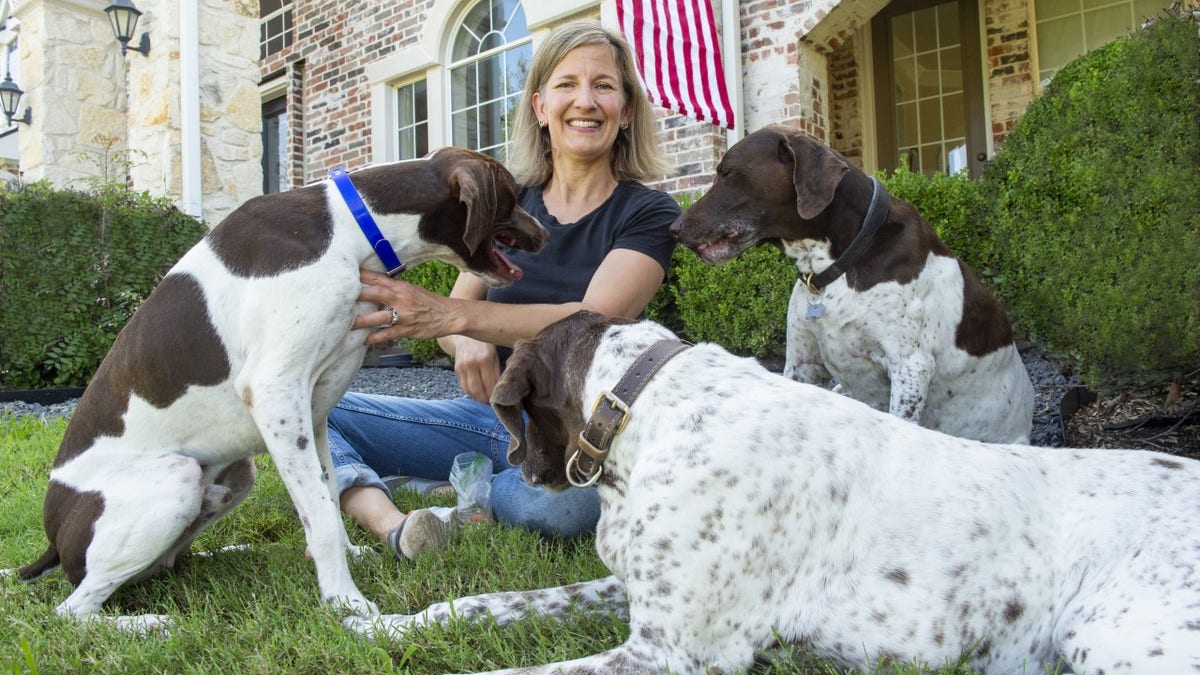Americans open their homes to foster pets amid coronavirus crisis
The ASPCA has a $5 million COVID-19 relief fund set up for shelters and pet owners.
The evidence of new families blended with people and pets arrived long before we considered what to call them.
"Multispecies families" captures the scientific essence, but the lifestyle and character of this four-legged/two-legged companion coalescence is far-reaching and even comes with a glossary: Dog Mom; Puppy Child; Baby Doll; GrandCat; Daddy’s Girl. And on and on.

Andrea Laurent-Simpson and some of the members of her family
The elevated state of companion animals is undeniable, and it’s no surprise family dynamics adjusted. Divorce courts now consider custody of the family pet. Millennial home buyers often pass on a home unsuitable for their dog. It’s become routine that rescue missions for pets occur before demolition of property touched by disaster.
KATE OBENSHAIN: 12 STEPS TO RAISING A CONSERVATIVE DAUGHTER – FROM MY VERY WISE DAUGHTER
By 2018, almost 61% of U.S. households owned pets, with dogs and cats topping the popularity list. Research from the American Veterinary Medical Association confirms our boundless bonds: 85% of dog owners and 76% of cat owners include their furry companions in the family fold. And, in the midst of a global pandemic, American spending on these family members in 2020 topped $103 billion – a $6 billion increase over spending in 2019.
I am an SMU Dallas researcher studying the evolving multispecies family. My recent book, "Just Like Family: How the Companion Animal Joined the Household," examines how we morphed to this point. Following 100 hours of observations in a veterinary clinic, dozens of interviews with pet owners and an analysis of scores of print advertisements flooding media, it’s obvious pets are more than generic "family members."
More from Opinion
- Sen. Marco Rubio: We must stop Silicon Valley-Democrat collusion before conservatives are silenced for good
- Sen. Tom Cotton: Biden's border crisis is a national emergency. Dems' shocking amnesty ploy must be stopped
- Janice Dean: DOJ won't investigate COVID nursing home orders – here's what I think will happen next
In my discipline, researchers talk of identities we humans assign to the family: "mom," "dad," "grandmother," "brother," or "sister." The presence of these kinds of identities extended to companion animals tells us American society has passed through the doggie door of a new order.
The way multispecies families appear depends on the kind of human family/household an animal companion joins:
Homes without children (by choice) – "I don’t spend enough time with my dog, so I am trying to change my schedule so that she has that time with me."
Households where people are unable to have human children – "Reading a story to my dog is something that she looks forward to every night!"
"Grandparents" get in on the action, too – with activities like "baby"sitting, financial support for expensive veterinary procedures, and sharing pictures of the grand cat with friends.
Families with children – "siblings" and "best friends" for kids who look to the family dog as a playmate and confidant and working parents who depend on four-legged family to greet their kids after school.
Of course, it took time for the multispecies family of today to evolve. Working dogs and cats in the 1800s became entertaining pets in the 1900s. Societal guilt over the ill treatment of animals throughout the Industrial Revolution made us more likely to pamper the family cat. Scholars argue that the 1970s realization that animals – dogs and cats especially – had personality and feelings is what led us to think of them differently.
Our emerging post-pandemic world is the most recent evidence of how these "blended" families are forcing massive institutional shifts.
But the multispecies family is also rooted in the same historical processes as other nontraditional families. Before the Industrial Revolution, parents focused on staying alive and having children to help provide for the family. But industrialization brought higher standards of living, lower death rates and longer lives. This allowed us to concentrate less on surviving and more on thriving – opening our lives to the possibility of self-happiness. Child-free families, single-parent families, declining marriage rates, and (for a time) increasing divorce rates all arose from these changes in modern society.
This state has also begot fully blended families where both human and furry non-human inhabitants equally enjoy the spoils of modern life. For child-free families – a category that has grown dramatically in the past 50 years – the question of whether a child might make them happy has been asked and answered. Dogs and cats paw in to fill a longing to nurture.
"Grandparents" readily shift over to spoiling the granddog as their daughters and sons choose instead to pursue lucrative careers. And parents with children today see happiness and self-esteem as paramount in raising healthy, happy adults – the sibling dog is a perfect relationship for fostering these goals.
Anchoring our cats in seatbelts and taking the dog for a walk in the stroller indicate this multispecies arrangement is here to stay. When changes in who can be treated as a child, sibling or grandchild occur across enough families, the broader cultural and institutional landscapes accommodate those new ideas.
Our emerging post-pandemic world is the most recent evidence of how these "blended" families are forcing massive institutional shifts. Gen Zers and millennials in particular are poised to leave their jobs out of concern for their multispecies family. And the pandemic-driven, record decrease in U.S. birth rates during 2020 likely portends more child-free couples who will grow new multispecies families.
In our new normal, institutional players ranging from social safety net policy makers to homebuilders to employers must take heed of the multispecies family like never before. Impoverished families struggling to feed themselves must also have policies that help with vet care and feeding their dogs and cats – otherwise they may be forced to surrender "family" in a way never before imagined.
CLICK HERE TO GET THE OPINION NEWSLETTER
It will be up to homebuilders and real estate agents to design or locate homes sensitive to both human and nonhuman needs – if not, then these multispecies families will seek shelter elsewhere.
And employers struggling to hire and retain workers burned out from the pandemic must realize that almost three-quarters of pet owners are anxious about leaving pets at home now. Management must shift to reflect this – or face an even tougher field as other corporations poach workers by offering flexible pet-at-work policies and on campus doggy day care.



